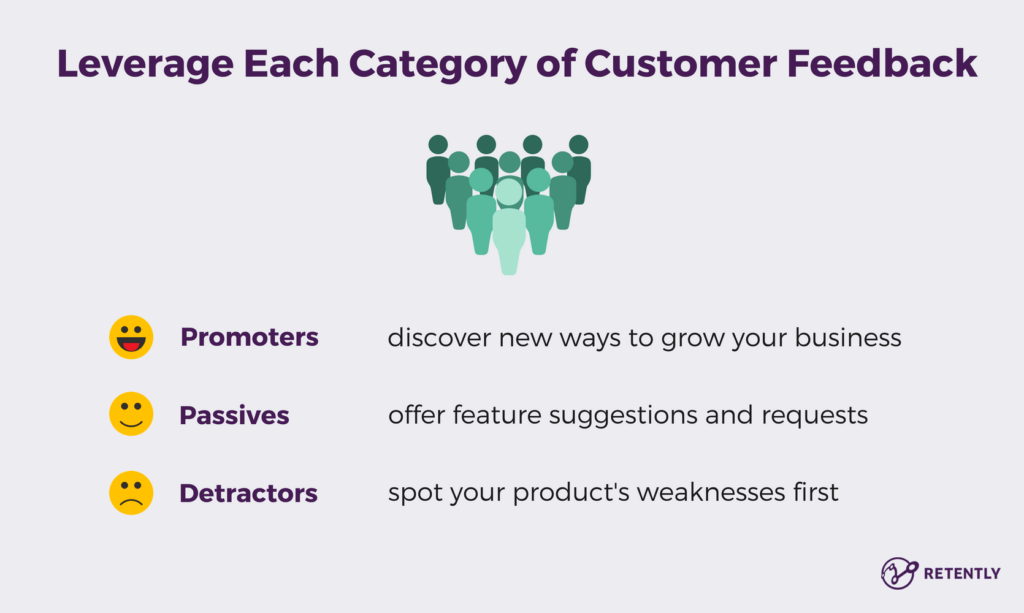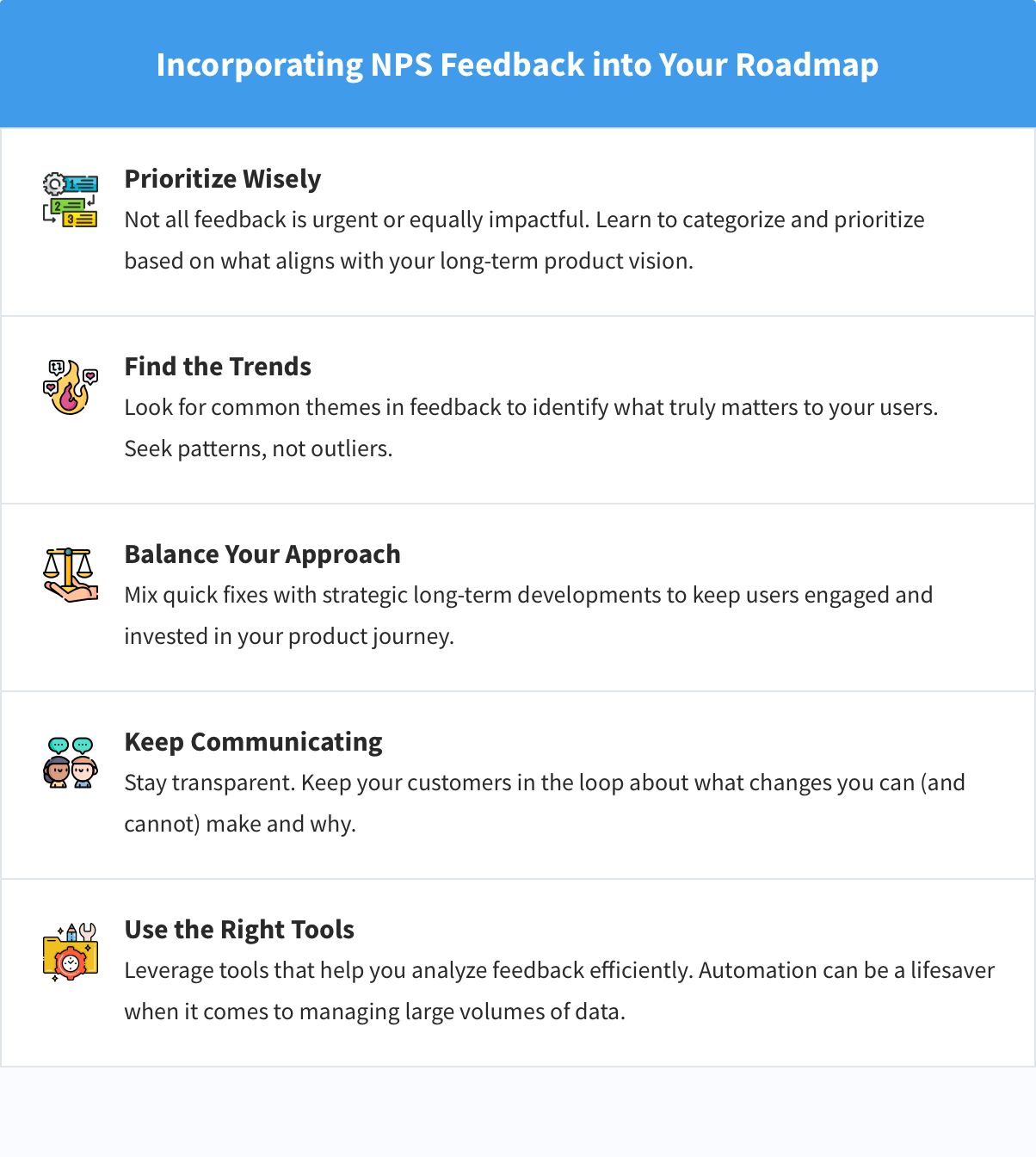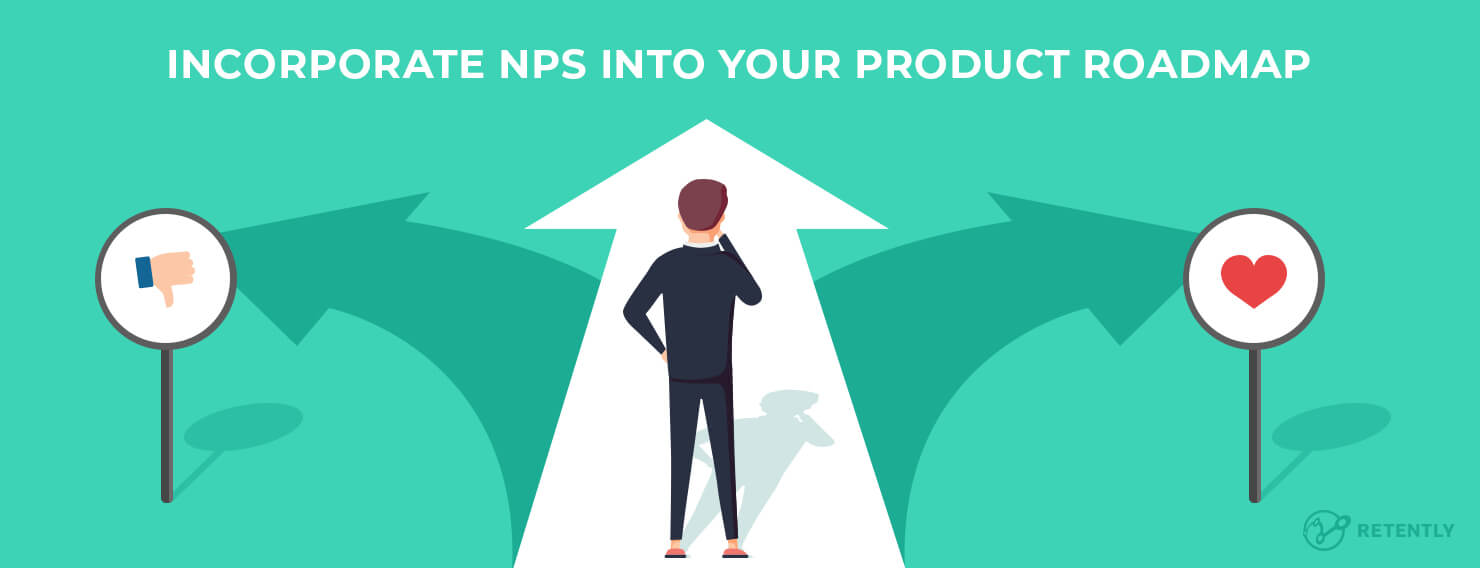Just like it’s difficult to drive to a new destination without a definite plan for how to get there, trying to build, launch and market a new product without a clear product roadmap guiding the development process is an exercise in vain.
A product roadmap is a strategic plan or statement of intent matching the vision and steps involved in a product’s development. A well-defined and goal-oriented roadmap allows the team to be on the same page and act in the same direction. In addition, it offers both executives and users a better understanding of the product to be developed, the features to be included and its timeline.
Net Promoter Score® can play a crucial role in your product roadmap improvement. By acquiring customer feedback about your product, you can avoid the most common development errors, spot and solve bugs before they become liabilities, prioritize features to work on, discover new marketing strategies, and have the ability to see the maturity of your newly released features through customer experience.
Below, we detail how to use NPS® and the acquired knowledge to guide your product roadmap. We’ve included actionable tips to help you apply NPS data as effectively as possible.
So, let’s dive into how we can make NPS feedback a cornerstone of your product development strategy, ensuring your product not only meets but exceeds customer expectations. Ready? Let’s get started.
Leverage Each Category of Customer Feedback
NPS groups customers into three categories based on their responses to one question: “How likely are you to recommend our product or service to a friend or colleague?”
Customers who give your product a score of 0-6 are Detractors, those who rate it a 7 or 8 are called Passives, and the ones scoring 9 or 10 are your Promoters. In our Net Promoter Score guide, we explain how these ratings collectively contribute to your final NPS score.
Whether we refer to Promoters, Passives, or Detractors, each has valuable feedback to offer that can be transposed into your product roadmap. Apart from the main NPS question, customers also answer an Open-Ended question that addresses the reason behind the score. The resulted qualitative feedback provides a comprehensive overview of what is liked, disliked or would need changes with regard to your product.
Leveraging the feedback given to you by each respondent segment allows you to incorporate valuable insights into your product roadmap. Further on, we take a closer look at how each survey respondent can help you improve your product offering.
Detractors
The first ones to usually spot your product’s weaknesses even at an early stage are your Detractors, making them a precious source of feedback. These are the users who are most likely to cancel their service or not make a repeat purchase, spreading negative virality about your business.
When the received criticism from Detractors is constructive and not merely a mean and unsustained comment, you can extract actionable knowledge from it. Detractors can be particularly valuable for bringing up easily manageable but at the same time important issues that skipped your team’s attention, such as:
- Bugs that need to be fixed. Sometimes a single bug is all it takes to lose a customer, especially if it affects their specific business processes.
- Misleading or inaccurate marketing claims. An innocent mistake or the wrong choice of words in a marketing campaign can make a customer feel like they’ve been misled or ripped off.
- Missing features. Detractors will often point out features offered by other products that yours doesn’t have. If a specific request keeps popping up in their feedback, it’s worth considering.
- Pricing plans. Detractors are usually the first to point out if one of your competitors offers something similar for a better price, making price-related feedback a noteworthy signal that you might need to adjust your pricing strategy.
These are all common issues in a Detractor’s feedback, topics easy to turn into action items for your next product meeting. Since they’re usually the reasons behind service cancellations, treating them as priorities to effect an increase in customer retention will prove efficient.
Implemented effectively, the feedback provided by Detractors can be extremely valuable for your business. By responding to your Detractors, adding their observations to your product roadmap and taking action, you can convert them into Promoters.
Passives
While Passives are not as likely to cancel their service in the short term or leave a negative review as Detractors, they can still be a source of ideas for your product’s enhancement.
To begin with, the Passives’ feedback often contains feature suggestions and requests that can be further incorporated, thus adjusting your product roadmap priorities.
Most Passives are happy with your product but still within the zone of “considering alternatives.” If a competitor adds a feature you don’t have, they might leave. This makes their feedback ideal as a source of mid-priority customer requests for your product roadmap.
Note that it is important to pay close attention to what your Passives are saying, but not make every feature request a top priority in your product roadmap. This will only lead to overstretching your resources for an all-in-one product that is too complicated to use. Prioritize feature requests according to company resources, feasibility and what works for your specific product.
As a general rule, while feedback and requests from Passives aren’t usually the “easy-wins” as compared to Detractors’, they are still worth consideration along with a place in your product roadmap. Use them properly to track your customer sentiment and deliver the best possible customer experience.
Promoters
The feedback from Detractors can help you plug leaks and stop your business from customer churn, while the one from Passives can help you identify new feature opportunities that give you an advantage over your competitors.
On the other hand, Promoters can play a key role in helping you discover new ways to grow your business. From a roadmap perspective, there are two ways to use Promoters’ inputs to your advantage.
First, their feedback is essential when calculating your Net Promoter Score. It goes without saying that the more Promoters you have, the higher your NPS is. Keeping track of the total percentage of Promoters and how it fluctuates is a good practice when implementing new action items and pushing releases.
If your NPS increases after a release that implements specific customer requests, you can take it as a validation of you making the correct decisions and prioritizing the right aspects of your product strategy.
The second is to look at the specific feedback you receive. When a Promoter lets you know that they enjoy your product, close the loop by asking for more information on what they like and how you can make your product even better.
Promoters are also the perfect target audience for implementing a referral marketing strategy. Because they are your most enthusiastic users and are willing to refer your brand to friends or colleagues, you can run a referral program and make this a systematic process that purposefully promotes your business through this word-of mouth-strategy.

Why NPS Should Guide Your Product Roadmap
Successfully bringing a product to market implies listening to customer feedback at every stage of the process and tailoring your product roadmap accordingly. Besides offering a quantitative metric of customer loyalty, NPS is also valuable for the following reasons:
- NPS surveys are the quickest and most reliable way of receiving qualitative input from your customers, that helps you make product adjustments.
- Changes in your Net Promoter Score shortly after big releases and product updates indicate customer sentiment with the new implementations. Often, this is the moment when you receive the most actionable product-related customer feedback.
- Measuring customer satisfaction is a long-term process, and so is improving a product. Keeping abreast of customer satisfaction trends allows you to make the necessary adjustments to your product as required.
- The positive feedback on a specific feature can be used as a morale booster by compiling the best responses and sending them to the members of your product team.
Therefore, linking NPS feedback to your product roadmap ensures you’re in harmony with your audience’s expectations. This is crucial because it:
- Drives Better Products: Feedback directly from your users tells you what’s working, what’s not, and what’s missing. Use this to adjust your roadmap to fit real user needs.
- Builds Trust: When customers see their feedback leading to real changes, they feel valued and heard. This boosts their loyalty and the chances they’ll recommend you to others.
- Enhances Decision Making: With direct insights from users, you can make smarter choices about which features to prioritize, ensuring you invest time and resources into updates that truly matter.
Challenges and Considerations
Integrating NPS feedback into product development is a strategic move that can significantly enhance customer satisfaction and business outcomes. However, this process comes with its own set of challenges and important considerations. Addressing these effectively can help ensure the success of your customer feedback initiatives.
Common Challenges
Integrating NPS feedback into your product roadmap isn’t just slapping customer suggestions onto a to-do list; it’s about making thoughtful decisions that align with your product’s vision and user needs. Let’s dive into some common roadblocks you might face and how to steer around them smoothly.
- Overwhelming Data: Sometimes, you get a flood of feedback. Sorting through every piece can feel like finding a needle in a haystack.
- Bias in Feedback: Let’s be honest, not all feedback is created equal. Sometimes, the loudest voices aren’t the most representative. This can skew your product development in the wrong direction if you’re not careful.
- Mixed Messages: For example, one day, your Promoters want feature X, and the next, your Detractors are ranting against it. Balancing these conflicting viewpoints is tricky.
- Short-term vs Long-term: It’s tempting to prioritize quick fixes that pacify vocal Detractors, but this might lead you off course from your long-term goals.
- Resource Allocation: Deciding how much time and which resources to devote to changes based on NPS can lead to tough calls. There’s always the risk of investing in the wrong areas.
Best Practices for Overcoming These Challenges
Integrating Net Promoter Score feedback into your product roadmap is not a one-off task but part of a continuous cycle of improvement that requires ongoing attention and refinement. Here’s how you can leap over these hurdles with grace:
- Prioritize Wisely: Not all feedback is urgent or equally impactful. Learn to categorize and prioritize based on what aligns with your long-term product vision. Use a framework to prioritize NPS feedback based on criteria like impact and feasibility. This helps you tackle the most beneficial changes first without getting swamped.
- Segment Your Data: Break down your NPS feedback by customer segments (like demographics, user type, etc.). This helps reduce bias and ensures you’re making decisions based on a comprehensive view of your user base.
- Seek Patterns, Not Outliers: Instead of getting stuck on every single comment, identify trends. If multiple users are highlighting the same issue, it’s a signal that it’s worth looking into. Look for common themes in feedback to identify what truly matters to your users.
- Balance Your Roadmap: Allocate slots in your roadmap for both quick wins and strategic initiatives. This helps maintain a healthy balance between addressing immediate user feedback and long-term product goals. Moreover, by balancing your approach (mixing quick fixes with strategic long-term developments) will keep users engaged and invested in your product journey.
- Iterate and Validate: Treat every change as an experiment. Implement, measure, and learn. This cyclical approach helps ensure you’re investing resources wisely and can pivot as needed based on new insights.
- Keep Communicating: Keep your users in the loop about what changes you can (and cannot) make and why. If a requested feature is too costly, explain why and discuss alternative solutions. Transparency builds trust.
- Use the Right Tools: Leverage tools that help you analyze and categorize feedback efficiently. Automation can be a lifesaver when it comes to managing large volumes of data.
- Stay Flexible: The needs of your customers will evolve, and so should your product. Be ready to adapt your roadmap as new feedback comes in, even if it means deprioritizing something else.

Collect Customer Feedback With Retently
Embracing NPS feedback is not just collecting scores but actively listening to your customers and letting their voices shape the future of your product. This ongoing engagement is key for improving your product and building lasting relationships with those who use it.
So, what’s your next step? Start small if you need to, but start now. Use the tools at your disposal to sift through feedback, spot the significant insights, and act on them. Remember, every piece of feedback is an opportunity to make your product better and your customers happier.
Ready to make your product roadmap not just a plan, but a dialogue with your users? Dive into your NPS feedback today and see where it can take you and your product. Make listening and improvement part of your daily routine.
Retently enables you to send customized Net Promoter Score surveys to your users and customers, helping you discover new product opportunities and find out what they like and dislike about it.
To get started, create your free trial account and survey your customers – no long-term contract obligation or credit card required. Remember, a product that grows with its users is a product poised for success. So, grab that feedback and turn it into your roadmap’s driving force.

















 Alex Bitca
Alex Bitca 






